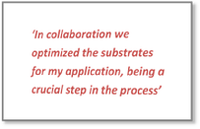 The thesis work of Hrudya Nair, under the guidance of dr. Arie van Houselt, was a fruitful cooperation between two research groups, one focused on catalysis, the other on fluid physics: Catalytic Processes and Materials (CPM), led by Prof. Leon Lefferts, and Physics of Fluids (PoF), led by Prof. Detlef Lohse. ‘Being a physicist, the chemistry part of the job was quite scary at first,’ Hrudya Nair says. ‘Now I have learnt not to limit myself to just one discipline.’
The thesis work of Hrudya Nair, under the guidance of dr. Arie van Houselt, was a fruitful cooperation between two research groups, one focused on catalysis, the other on fluid physics: Catalytic Processes and Materials (CPM), led by Prof. Leon Lefferts, and Physics of Fluids (PoF), led by Prof. Detlef Lohse. ‘Being a physicist, the chemistry part of the job was quite scary at first,’ Hrudya Nair says. ‘Now I have learnt not to limit myself to just one discipline.’

The way Hrudya Nair produces carbon nanowires is by using the thermal catalytic chemical vapor deposition method. This is achieved directly on silicon substrates. Not needing to add chemical coatings, the method is very advantageous. After systematically experimenting, characterizing and optimizing the substrates and processing conditions, like temperature and surrounding gas conditions, Hrudya is now proud to announce she was able to come up with stable, reproducible and uniform nanowires, possessing unique wettability properties she hardly could have dreamt of when starting her PhD.
TUNABLE AND STABLE
In flow channels all contact angles of carbon nanowires – from hydrophobic to hydrophilic – are realizable now. She explains: ‘This can be done by tuning the growth time. Furthermore, the adhesion of carbon nanofibers on Ni/Ta (nickel/tantalum) is excellent. The nanowires stay stable for long periods of time, even under severe process conditions, for example when exposed to high temperatures up to 500 degrees centigrade.’

The carbon nanowires can be integrated in flow channels of silicon-based microfluidic systems, thereby offering numerous applications. Hydrophobic or superhydrophobic substrates can reduce drag in microchannels, helping to control pressure drops whilst in service. In fuel cells they can replace the gas diffusion layer thereby increasing the oxygen transport and water removal. On the other side of the spectrum hydrophilic, even suprahydrophilic, properties are within reach, facilitating future applications at various catalyst support devices.
These carbon nanofiber substrates are dynamically robust and the evolution of contact angle and droplet mass upon drop evaporation, can be collapsed onto one universal curve, for all droplet sizes and all initial contact angles. Carbon nanofibers delayed the transition temperature from contact to film boiling, and physical arguments were presented showing that, because of the small scale of the fibers, they are cooled by vapor flow just before the impact, thereby permitting contact boiling to much higher temperatures than on smooth surfaces. This has considerable implication for various applications that require high operating temperatures, because carbon nanofibers can operate at higher temperatures while still maintaining contact with the liquid.
OPTIMIZATION OF THE SUBSTRATES

In addition to CPM and PoF even Mesoscale Chemical Systems (MCS) collaborated in this PhD-work. Prefabricating the silicon substrates the expertise brought in by dr. ir. Roald Tiggelaar was indispensable, Hrudya lets know. ‘In collaboration we optimized the substrates for my application, being a crucial step in the process. ’Nanofabrication techniques and cleanroom experience were among the new things Hrudya became acquainted with. ‘At first I was quite scary having to learn all these new skills. Especially the chemistry part was brand new for me, being a physicist originally. Now I appreciate chemistry as a field of knowledge and research, though I still like physics more. During the PhD project I have learnt not to limit myself to just one discipline, not being afraid to seek new horizons. By not limiting myself to one topic, I was able to combine different routes, which led to some very nice results.’
BENEFICIAL TO SOCIETY
Publications appeared in high ranked journals, such as: Soft Matter, Chemical Engineering Journal, Physical Review E and Thin Solid Films. ‘After staying in academics for some time, I would like to work in industry at a R&D group now,’ Hrudya says. ‘I would like to be beneficial to society in a more direct way. Combining my skills in physics and chemical engineering might be very promising, for example in fluid mechanics or in designing microchannels in lab-on-a-chip devices. Striving for collaborations will always be part of my working approach, I believe. It broadens one’s views and knowledge. Also specific problems can be solved much more efficiently when ’meeting the right experts in new fields.’
